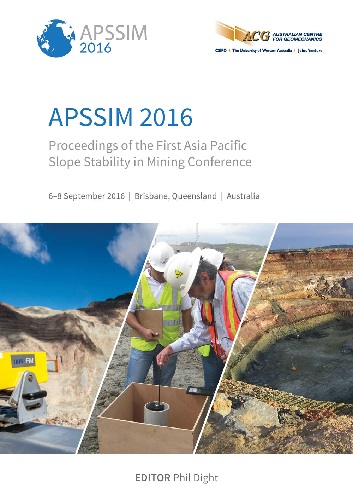Remediation of the uranium mill tailings pond Dänkritz 2 — seismic slope stability analysis and serviceability limit state design

|
Authors: Koitzsch, Y; Klemm, S; Muehl, A; Barnekow, U; Speer, M |
DOI https://doi.org/10.36487/ACG_rep/1604_35_Koitzsch
Cite As:
Koitzsch, Y, Klemm, S, Muehl, A, Barnekow, U & Speer, M 2016, 'Remediation of the uranium mill tailings pond Dänkritz 2 — seismic slope stability analysis and serviceability limit state design', in PM Dight (ed.), APSSIM 2016: Proceedings of the First Asia Pacific Slope Stability in Mining Conference, Australian Centre for Geomechanics, Perth, pp. 531-544, https://doi.org/10.36487/ACG_rep/1604_35_Koitzsch
Abstract:
The remediation of the East German uranium mining sites operated and used until 1990 started in 1991 and was funded by the German Federal Government. However, most of the numerous abandoned uranium mining sites of third party property that were distributed all over Saxony were not included. In 2003 the Federal Government and the Free State of Saxony agreed to jointly fund the remediation of those abandoned mining sites of high priority. Wismut´s department for Project Management of Wismut´s Abandoned Saxonian Mining Sites was given the responsibility for the project management. The Dänkritz 2 uranium mill tailings pond is one of those abandoned sites (area: ca. 11 ha; vol. ca. 0.9 Mill. m³). Mill tailings were discharged during the 1950s surrounded by a max. 12 m high autostable ring dam, which was already reshaped during the 1960s to improve geotechnical stability. Dynamic stability calculations, applying the finite element program PLAXIS, were carried out by CDM Smith as part of the remediation design. They resulted in insufficient dynamic stability with respect to the maximum credible earthquake. In addition, soft fine-grained tailings needed to be stabilised to place a multi-layer type surface cover. Wismut designed the tailings remediation project. The paper will particularly focus on the advanced constitutive models used for the slope stability analyses of the embankment under dynamic loads and of the stability of the fine-grained tailings during interim cover placement.
Keywords: stabilisation of tailings management areas, tailing pond remedation, uranium mill tailings, dynamic numerical analyses
References:
Alpan, I 1970, ‘Geotechnical properties of soils’, Earth-Science Reviews, rev. 6, pp. 5–49.
Benz, T 2007, ‘Small Strain stiffness of soils and its numerical consequences’, PhD thesis, University of Stuttgart.
Benz, T, Schwab, R & Vermeer, PA 2006, ‘A small strain overlay model, I: model formulation’, International Journal for Numerical and Analytical Methods in Geomechanics, vol. 33, no. 1, pp. 25–44.
Brinkgreve, RBJ, Kappert, MH & Bonnier, PG 2007, ‘Hysteretic damping in a small-strain stiffness model’, in GN Pande & S Pietruszczak (eds), Numerical Models in Geomechanics, Taylor & Francis Group, London.
Darendeli, MB 2001, ‘Development of a New Family of Normalized Modulus Reduction and Material Damping Curves’, PhD thesis, Department of Civil Engineering, The University of Texas at Austin.
DIN 19700-15 2004-07, ‘Stauanlagen, Teil 15 – Sedimentationsbecken’.
DIN 4149 2005-04, ‘Bauten in deutschen Erdbebengebieten - Lastannahmen, Bemessung und Ausführung üblicher Hochbauten’ (replaced by DIN EN 1998-1/NA 2011-01).
DIN EN 1998-1 2010-12, ‘Eurocode 8 - Auslegung von Bauwerken gegen Erdbeben - Teil 1: Grundlagen, Erdbebeneinwirkungen und Regeln für Hochbauten’.
DIN EN 1998-1/NA 2011-01, ‘Nationaler Anhang - National festgelegte Parameter - Eurocode 8: Auslegung von Bauwerken gegen Erdbeben - Teil 1: Grundlagen, Erdbebeneinwirkungen und Regeln für Hochbau’.
Fellenius, WKA 1936, ‘Calculation of the Stability of Earth Dams’, in Transactions of the Second Congress on Large Dams, Washington DC, 4, pp. 445–462.
Schanz, T, Vermeer, PA & Bonnier, PG 1999, ‘Formulation and verification of the Hardening-Soil Model’, in RBJ Brinkgreve, Beyond 2000 in Computational Geotechnics, Balkema, Rotterdam, pp. 281–290.
Tensar International Limited 2003, The Properties and Performance of Tensar Biaxial Geogrids, Tensar SS geogrid specifications Issue 3, 79010055.
© Copyright 2025, Australian Centre for Geomechanics (ACG), The University of Western Australia. All rights reserved.
View copyright/legal information
Please direct any queries or error reports to repository-acg@uwa.edu.au
View copyright/legal information
Please direct any queries or error reports to repository-acg@uwa.edu.au